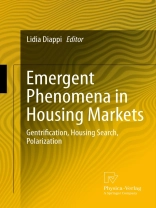The housing market, like every market, is the product of thousands of interacting buyers and sellers driven by different interests. But unlike other markets, the housing market is able to profoundly transform the socioeconomic structure and the image of a city. Very often, changes in urban space are the result of the imperceptible operation of a multitude of micro-transformations which act with such great energy and decisiveness that they can transform the ‘DNA’ of entire urban neighborhoods. These qualitative novelties, unpredictable and non-deducible on the basis of the previous properties, are defined emergences. Namely emergence means a ‘pattern formation’ characterized by a self-organizing process driven by non-linear dynamics. This book explores housing market emergence in light of three different phenomena: search for housing, social polarization, and gentrification. The book is divided into two parts. The first part presents contributions on modelling emergence of different phenomena, formalised in multi-agent systems. The second part gathers empirical research and analyses aimed at supporting the findings of the models.
สารบัญ
Introduction.- Part I: Modeling the Spatial Behavior of Agents.- Part II: Empirical Investigations.
เกี่ยวกับผู้แต่ง
Lidia Diappi is a Professor in the Department of Architecture and Planning at the Polytechnico of Milan, Italy.












